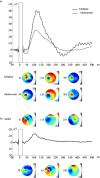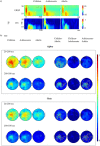Development of cortical motor circuits between childhood and adulthood: A navigated TMS-HdEEG study
- PMID: 28218489
- PMCID: PMC6866783
- DOI: 10.1002/hbm.23545
Development of cortical motor circuits between childhood and adulthood: A navigated TMS-HdEEG study
Abstract
Motor functions improve during childhood and adolescence, but little is still known about the development of cortical motor circuits during early life. To elucidate the neurophysiological hallmarks of motor cortex development, we investigated the differences in motor cortical excitability and connectivity between healthy children, adolescents, and adults by means of navigated suprathreshold motor cortex transcranial magnetic stimulation (TMS) combined with high-density electroencephalography (EEG). We demonstrated that with development, the excitability of the motor system increases, the TMS-evoked EEG waveform increases in complexity, the magnitude of induced activation decreases, and signal spreading increases. Furthermore, the phase of the oscillatory response to TMS becomes less consistent with age. These changes parallel an improvement in manual dexterity and may reflect developmental changes in functional connectivity. Hum Brain Mapp 38:2599-2615, 2017. © 2017 Wiley Periodicals, Inc.
Keywords: adolescent; adult; child; electroencephalography; gamma-Amicobutyric Acid; motor cortex; transcranial magnetic stimulation.
© 2017 Wiley Periodicals, Inc.
Figures






References
-
- Awiszus F (2003): TMS and threshold hunting. Clin Neurophysiol Suppl 56:13–23. - PubMed
-
- Awiszus F (2012): On relative frequency estimation of transcranial magnetic stimulation motor threshold. Clin Neurophysiol 123:2319–2320. - PubMed
-
- Barnea‐Goraly N, Kwon H, Menon V, Eliez S, Lotspeich L, Reiss AL (2004): White matter structure in autism: Preliminary evidence from diffusion tensor imaging. Biol Psychiatry 55:323–326. - PubMed
-
- Bartzokis G, Beckson M, Lu PH, Nuechterlein KH, Edwards N, Mintz J (2001): Age‐related changes in frontal and temporal lobe volumes in men: A magnetic resonance imaging study. Arch Gen Psychiatry 58:461–465. - PubMed
-
- Battino D, Estienne M, Avanzini G (1995): Clinical pharmacokinetics of antiepileptic drugs in paediatric patients. Part II. Phenytoin, carbamazepine, sulthiame, lamotrigine, vigabatrin, oxcarbazepine and felbamate. Clin Pharmacokinet 29:341–369. - PubMed
Publication types
MeSH terms
LinkOut - more resources
Full Text Sources
Other Literature Sources
Medical

